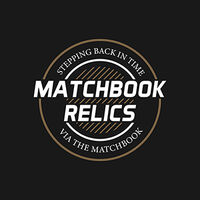In the mid-20th century, police departments discovered an innovative way to connect with their communities and promote public safety: matchbooks. These small, practical items became a powerful tool for community outreach and public service announcements, helping police departments reach a wide audience and foster trust within the community. This article explores how police departments ingeniously utilized matchbooks to enhance their public service efforts and build positive relationships with the public.
Matchbooks as Tools for Public Service Announcements
Police departments used matchbooks as a convenient medium for disseminating important public service announcements. The covers of these matchbooks often featured crucial information such as emergency phone numbers, crime prevention tips, and safety advice. Common messages included reminders like "Lock Your Doors," "Report Suspicious Activity," and "Buckle Up for Safety." By placing these vital messages on an item that people used regularly, police ensured that safety reminders were constantly visible and accessible.
The matchbooks also prominently displayed the police department's name, logo, and contact information, making it easy for community members to reach out for assistance or report incidents. This continuous visibility helped reinforce the role of the police as protectors and supporters of the community.
Promoting Community Programs and Initiatives
Beyond safety tips, matchbooks were also used to promote community programs and initiatives led by police departments. These programs often included neighborhood watch groups, youth engagement activities, and community policing efforts. Matchbook covers might feature slogans like "Join Your Neighborhood Watch" or "Get Involved with Your Community Police," along with details on how to participate.
By distributing these matchbooks in local businesses, schools, community centers, and at public events, police departments ensured that information about these programs reached a wide audience. This not only increased participation but also fostered a sense of community involvement and cooperation in maintaining public safety.
Engaging the Community through Outreach
Matchbooks served as an effective tool for community outreach, helping police departments build positive relationships with the public. The designs often included images of friendly police officers, patrol cars, or community events, creating a sense of approachability and trust. Slogans like "Your Partner in Safety" or "Serving with Pride" reinforced the department's commitment to serving the community.
Police departments distributed matchbooks during school visits, community fairs, and neighborhood meetings. This direct engagement allowed officers to connect with residents, educate them about public safety, and address any concerns they might have. The tangible nature of matchbooks made them a lasting reminder of these interactions, helping to build ongoing trust and rapport.
Fostering Trust and Reliability
Using matchbooks as a promotional tool helped police departments establish themselves as reliable and approachable community resources. The continuous presence of these matchbooks in daily life reinforced the idea that the police were always available and ready to help. This was particularly important for fostering trust and ensuring that community members felt comfortable reaching out to the police in times of need.
The matchbooks' practical utility and the important information they conveyed helped position the police department as a proactive and caring entity within the community. This trust-building was essential for effective policing and community cooperation.
A Touch of Nostalgia and Collectibility
The nostalgic charm of vintage matchbooks also played a role in their effectiveness. The simple, yet impactful designs evoked a sense of tradition and community spirit. Many people kept these matchbooks as collectibles, further extending their reach and impact. They served as cherished reminders of the police department's role in the community and the importance of public safety.
Conclusion
The use of vintage matchbooks by police departments was a strategic and effective way to promote community outreach and public service announcements. By turning these everyday items into valuable sources of information and reminders of their presence, police departments ensured that their messages were visible, accessible, and trusted. The practical utility and thoughtful design of matchbooks helped build public awareness, foster community support, and enhance the effectiveness of their services. Today, these vintage matchbooks serve as charming relics, illustrating the innovative ways in which police departments connected with their communities and promoted their vital mission of public safety.
